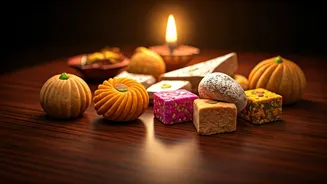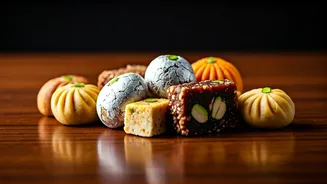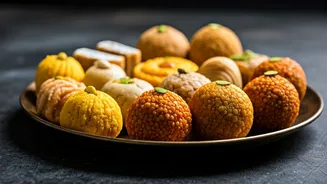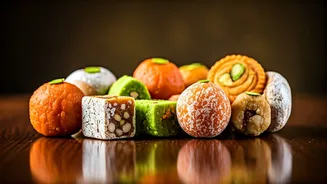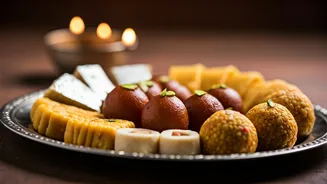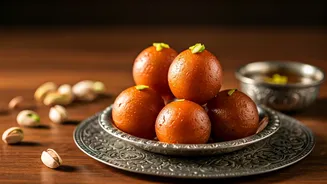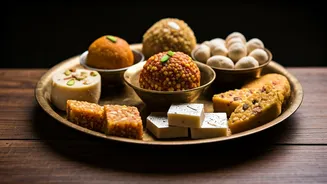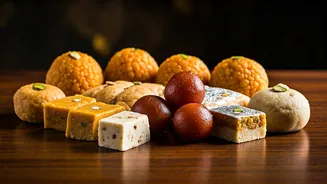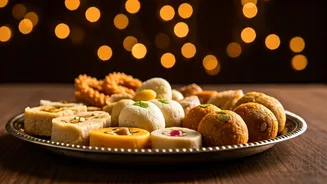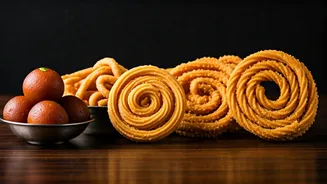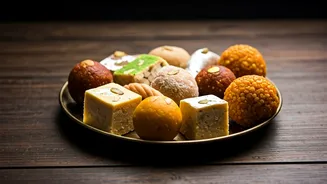Sweet Beginnings: Beyond Gulab Jamun
Diwali celebrations in India are incomplete without the indulgence in sweets, but the culinary landscape of India extends far beyond the common gulab jamun.
The article suggests going beyond the well-known treats and exploring the hidden gems within the Indian sweets category. These lesser-known sweets offer a diverse range of flavors and textures, reflecting the unique culinary traditions of different regions. This approach encourages readers to broaden their Diwali dessert choices and discover the rich variety of sweets available. It highlights the vast and diverse world of Indian confectionery beyond the staples, promoting a deeper appreciation for the country's culinary heritage during the festive season. Exploring these alternatives enhances the Diwali experience with unique flavors and cultural significance.
Regional Sweet Spotlights
India's regions each possess unique sweet traditions, showcasing the country's diverse culinary landscape. In West Bengal, Sandesh, a milk-based sweet, is popular, with variations from soft, crumbly textures to those with elaborate designs. Moving to Rajasthan, the sweet, crispy Ghevar is made from maida and soaked in sugar syrup, adding to the region's rich dessert offerings. South India presents Payasam variations, like the creamy, rice-based Pal Payasam, flavored with cardamom and nuts, highlighting the region's penchant for rice and dairy-based sweets. In Maharashtra, Puran Poli, a sweet flatbread stuffed with a sweet lentil filling, stands out as a festive favorite. These diverse sweets reflect the ingredients and cooking techniques specific to their regions, offering a delicious journey through India's varied culture. Each sweet tells a story of its origin, ingredients, and traditional preparation methods, providing a rich, immersive exploration of Indian sweets beyond the usual.
Key Ingredients And Traditions
The creation of Indian sweets highlights the usage of key ingredients and time-honored traditions. Ingredients like milk, ghee, sugar, and various flours form the base for many sweets, providing richness and structure. Spices like cardamom, saffron, and nutmeg introduce complex flavors, enhancing the overall taste and aroma. Traditional methods like slow cooking, deep-frying, and intricate shaping play important roles in the sweet-making process. Milk-based sweets, often cooked for hours to reduce and thicken the milk, showcase the patience and skill of the creators. The use of ghee for frying adds richness and a distinct flavor profile. Sugar syrups and jaggery provide sweetness and glazes, while nuts and dried fruits add texture and decoration. The combination of these ingredients and techniques yields a vast array of unique sweets that are vital to India's culinary identity, continuing for generations.
Diwali Sweet Significance
Sweets hold a crucial position in Diwali, symbolizing the festival's joy and prosperity. They are an integral part of gift-giving, celebrations, and sharing the spirit of togetherness with loved ones. Offering sweets to deities is a long-standing tradition, expressing gratitude and seeking blessings for the upcoming year. The act of sharing sweets with family, friends, and neighbors reinforces the communal spirit, spreading happiness and strengthening bonds. Each sweet carries a special significance and represents different cultural values, which further enhances the festive joy. By understanding the significance of sweets, it's possible to deeply appreciate their role in creating a joyful and memorable Diwali experience, encouraging shared experiences and reinforcing community ties. The sweets symbolize a season of optimism and the hope of a prosperous future.
Sourcing and Preparation Tips
Discovering unique Diwali sweets begins with careful sourcing, whether it is visiting local sweet shops or exploring online vendors. Inspecting the source for quality ingredients and authentic recipes is crucial to ensure an exceptional experience. For those interested in homemade sweets, start by finding trustworthy recipes and familiarizing yourself with ingredient measurements and preparation methods. Experimenting with lesser-known sweets can be made simpler with detailed instructions, beginner-friendly guides, and ingredient substitutions. For example, if a specific ingredient is unavailable, there are often alternatives that won't compromise the taste. Embrace the opportunity to learn, explore, and share your creations with others. Embrace the opportunity to learn, explore, and share your creations with others. The journey of finding and preparing exotic Diwali sweets provides a chance to grow one's culinary skills and expand your understanding of Indian culture.
Beyond the Feast: Cultural Context
The exploration of Indian sweets extends beyond the food itself, immersing into the rich cultural history and regional significance. Each sweet represents a part of the cultural tapestry and traditions specific to its place of origin. Many sweets are tied to certain festivals, family celebrations, and religious rituals, highlighting their significance in marking important occasions. The creation and consumption of sweets are often rooted in familial practices, with recipes passed down through generations. These sweets symbolize good fortune, positive energy, and happiness, enhancing the festive spirit and fostering a sense of community. By exploring the cultural context of sweets, one can deepen their appreciation for the dishes and the traditions that create these flavors.
Embracing New Sweet Treats
This Diwali, step out of your comfort zone and explore the world of unique Indian sweets. Discovering these hidden gems enriches your festive celebrations and introduces you to the vastness of Indian culinary culture. Whether enjoying them at a local sweet shop or trying your hand at making them at home, these sweets offer a fresh and interesting experience. Sharing these uncommon desserts with loved ones turns them into memorable experiences, as it sparks conversation, learning, and cultural exchange. Every unique sweet offers a glimpse into a region's history, traditions, and the joy of sharing new experiences. Embrace this opportunity to expand your knowledge of Indian cuisine, creating a Diwali that is both delicious and culturally enriching.
